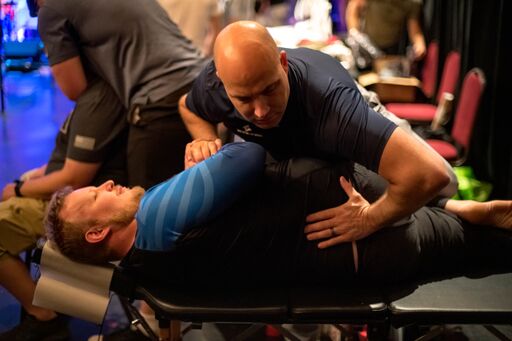
Evaluate, Fix, Prevent
Far too often in today’s healthcare system, patients are being let down by their healthcare providers. As the patient, you deserve to be guided back from injury appropriately and efficiently. Too many injured and ailing people are not thoroughly evaluated, therefore not receiving appropriate care, nor are they given a game plan to prevent the pain or injury from returning in the future.
There are 3 fundamental aspects of care that YOU deserve and expect as a patient.
-
- Comprehensive Evaluation and Assessment
- Conservative Treatment Options
- Prevention Training
Comprehensive Evaluation and Assessment
Too often a patient presents to their primary care physician or specialist and are given a proper history and consultation, but a very low-level musculoskeletal exam. Many do not even touch their patients! The doctor doesn’t even assess the muscle tissue, joint function, or the movement of the patient. How can you perform a musculoskeletal diagnosis without assessing movement! It’s absolutely crazy! They may perform a few tests, may refer you for some diagnostic imaging, before concluding that you must rest for 6 weeks and finally prescribe you some medication to help “manage” your condition. They may even recommend surgery! This type of care inefficient, raises the cost of healthcare and promotes fear of movement.
As a patient, it is important to understand what you should expect from a comprehensive evaluation and assessment. Your evaluation and assessment should provide you with a working diagnosis and the potential direct and indirect causes of the pain or injury. The diagnosis should be specific and clearly communicated.
In order to determine an appropriate working diagnosis a comprehensive evaluation should include, but is not limited to:
- A thorough History & Consultation
- Functional Assessment: Assessing weakness, tightness, faulty movement patterns.
- Orthopedic Exams, Range of Motion, Neurological testing as needed.
- Muscle and Joint Palpation/Testing.
- Gait Analysis (if deemed necessary)
When a thorough evaluation and assessment is performed it provides the healthcare provider with the information required to determine the appropriate course of care. This allows for an informed decision regarding which conservative treatment options would be best suited for your individual case.
Conservative Treatment Options
In my opinion, you deserve to have a comprehensive hands-on approach to your pain or injury. Most patient presentations respond best to a specific combination of therapies. This may include manual therapy, chiropractic manipulation, rehab exercises, laser, PEMF, spinal decompression, cupping, or acupuncture and advice on how to train and prevent further exacerbations of the injury. You may not need all treatment for all pain or injuries, but many will optimally benefit a combination of the approaches above.
Conservative treatment should not be a “one size fits all” approach. Every patient has an individual mechanism of injury and will require unique treatment plan! With multiple therapies available, each which targets different tissues it is important that your care plan is individualized based on the findings from your comprehensive assessment.
Prevention Training
There are few things more frustrating from both the patient’s or doctor’s perspective than the return of the pain or injury. There are many potential factors that can contribute to re-aggravation of your injury or symptoms. These include over-use strain from work, life or sport, not following the prescribed exercises, or the lack of injury prevention training from your healthcare provider. As an informed patient, these are a sample of some prevention options you should expect instructions on.
- Activities of Daily Living Training: Many activities we do in our daily life cause physical strain when performed improperly.
- Return to Work/Sport Advice: Proper time frame for return and potential modifications.
- Body Awareness and Preparation: Proper lifting, bending, posture, etc.
- Corrective Exercises: Core stability exercises.
- Desk Ergonomics Tips: Desk sitting is causing many of your conditions.
- Proper Equipment recommendations: Proper running shoes for a runner.
- Skills/Technique Training, such as golf swing technique from a teaching professional.
To summarize, there are many potential shortcomings that you may experience when you see any healthcare provider for your musculoskeletal pain or injury. The first step is being an informed patient and understanding what quality care entails. I have outlined some key points that you as an informed patient should come to expect from your provider when you seek treatment for any musculoskeletal condition.
- A comprehensive assessment including but not limited to a thorough history, a functional movement assessment, palpation (assessing by hand) of the joints, muscles, tendons and ligaments
- An exam that assesses the body as a whole in order to determine the root cause, and does not only focus on the point of pain, but identifies contributing factors. For example, a patient with low back pain has hip range-of-motion and mid-back mobility issues that have led to the low back being over-worked. If those are not addressed, the lower back pain may return.
- A specific working diagnosis based from the comprehensive exam.
- All your conservative treatment options should be explained and discussed, offering you a chance to ask any questions you might have and provide clarity regarding our plan.
- You should expect to receive advice regarding preventative care for your injury, so once you are out of pain, you can avoid re-injury or aggravations.
Do you want a comprehensive exam and a the best, cutting edge treatment that Woodbury, MN has to offer? Schedule an appointment now! https://www.mnspineandsport.com/appointments/

